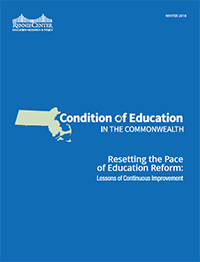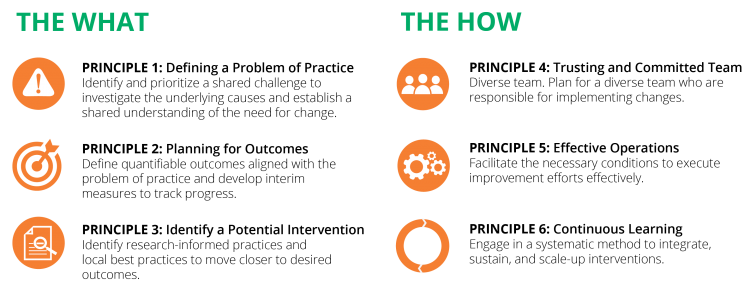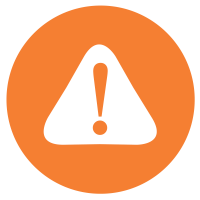A key piece of our Condition of Education in the Commonwealth report, the Action Guide provides research-informed recommendations for statewide actions—policies, investments, and expansion of effective practices—that have potential to address performance gaps and contribute to broad improvement in student outcomes. In our last three Condition of Education Action Guides, we called on the Commonwealth to consider education more holistically, noting that schools should not—and cannot— work in isolation and that each child’s education encompasses more than academic learning.
 2018 Action Guide: Resetting the Pace of Education Reform: Lessons of Continuous Improvement
2018 Action Guide: Resetting the Pace of Education Reform: Lessons of Continuous Improvement
This year, our fifth Condition of Education report, will reflect more broadly on the pace and progress of school improvement in our state. As in past reports, we will examine multiple points across the education pipeline, from early education through college and career preparation. Irrespective of the specific point in the pipeline, the 2018 report will highlight how practitioners are learning to achieve and sustain meaningful improvement through locally constructed change processes.
A LOCAL LENS ON IMPROVEMENT
Partnering with Commonwealth schools and districts that currently engage in a continuous learning process has had a profound impact on how the Rennie Center thinks about effective, and sustainable change. This knowledge has guided the creation of Rennie’s Change Management Framework, a rigorous, structured approach to planning and implementing district and school improvement strategies. The Rennie Center’s Change Management Framework outlines a set of steps that teams of educators can use to manage their own improvement processes. The Framework is organized around two key ideas:
- Defining the purpose and approach (the “what”): Teams must first have clarity about the reason to embark on any reform strategy by articulating the problem that they are trying to address. They must also have a clear idea of what they are hoping to achieve by defining success metrics. Once these critical pieces are confirmed, the team must select practices or interventions that will address the problem and help them reach their intended outcomes.
- Determining the methods for achieving goals (the “how”): After clarifying the purpose, goal, and potential approaches for improvement, the team must delineate how they plan to lead, support, test, and refine implementation.
By bringing together the what and the how, the Change Management Framework is intended to help teams design and maintain effective improvement strategies resulting in sustainable education reform.

CONTINUOUS LEARNING FROM LOCAL EXAMPLES
Defining an Actionable Problem of Practice: A community-wide approach to addressing school readiness.
 Developing a clear definition of an actionable problem of practice to strengthen the transition between preK and kindergarten enabled early educators in Springfield to identify specific contributing causes to the community-wide gap in readiness and explore factors that could drive improvement.
Developing a clear definition of an actionable problem of practice to strengthen the transition between preK and kindergarten enabled early educators in Springfield to identify specific contributing causes to the community-wide gap in readiness and explore factors that could drive improvement.When confronted with a 12% readiness rate throughout the district, Springfield could have set out to plan and implement any number of reform strategies.
- Identify potential drivers of improvement. Springfield consulted student outcome data and community-wide instructional practice to identify potential levers for improvement.
- Build Consensus. Springfield assesses student learning and regularly evaluates the expectations of early education providers in light of academic expectations in the elementary grades to ensure that the youngest learners are well-positioned for success in school.
- Ensure articulated problems of practice are actionable. Springfield is working to enhance the applicate of data to school readiness issues by crafting data sharing agreements, whereby community stakeholders can have seamless access to multiple types of data across sites.
Planning for Outcomes: A statewide, multi-community approach that strengthens the secondary-to-postsecondary transition.
100 Males to College site leads can identify and share measurement techniques for monitoring and assessing progress against specific community-level goals that were set by analyzing multiple data sources.
- Planning for outcomes. Leveraging state-level indicators, 100 Males to College utilizes this information to identify, set targets for, and track local program outcomes.
- Identify measures to monitor progress. The 100 Males to College sites utilize data as a flashlight to both inform the planning and development of their programs and assess the impact of their work.
- Foster local partnerships to align outcomes. The collective impact approach of 100 Males to College provides an example of how communities can convene partners to share best practices and progress towards goals.
Identify a Potential Intervention: A school-wide adoption to improving teaching and learning.
Because the Henderson staff had a clear sense of what they hoped to accomplish, they were able to avoid the “square peg, round hole” dilemma—that is, implementing a practice or intervention that may be effective in theory, but which doesn’t align with the students’ needs and the team’s vision for success.
- Build a common notion of local needs among educators. The Henderson utilized a collaborative approach to identifying strengths and areas for growth to improve teaching and learning for all.
- Pinpoint a common approach. The mission-driven focus at the Henderson provided opportunities for staff to use data to identify student learning needs and existing effective practices within the school that could address them.
- Foster educator learning. School leadership at the Henderson committed to the psychological safety of the staff, creating a space where experimentation and adaptability is encouraged.
CONTINUOUS LEARNING for the Commonwealth | State Supports
Each of these local examples provides important insight into how, by supporting local communities in doing the hard work of continuous learning, the state can bolster local change processes. Here are some strategies that address how:
- Focus on linking systems with practical tools and resources to connect communities.
- Enhance incentives for shared professional development to encourage community-level coherence.
- Foster agency collaboration to address child outcomes and strengthen the school-community landscape.
- Increase professional development and learning for all educators to support the fidelity of implementation of strategies.
- Expand pathways for educator licensure with options for dual licenses, to enhance educators’ expertise.
- Convene communities of educators to collaborate on local planning and implementation efforts.
- Enhance access to and use of common data across schools, agencies, and community partners.
